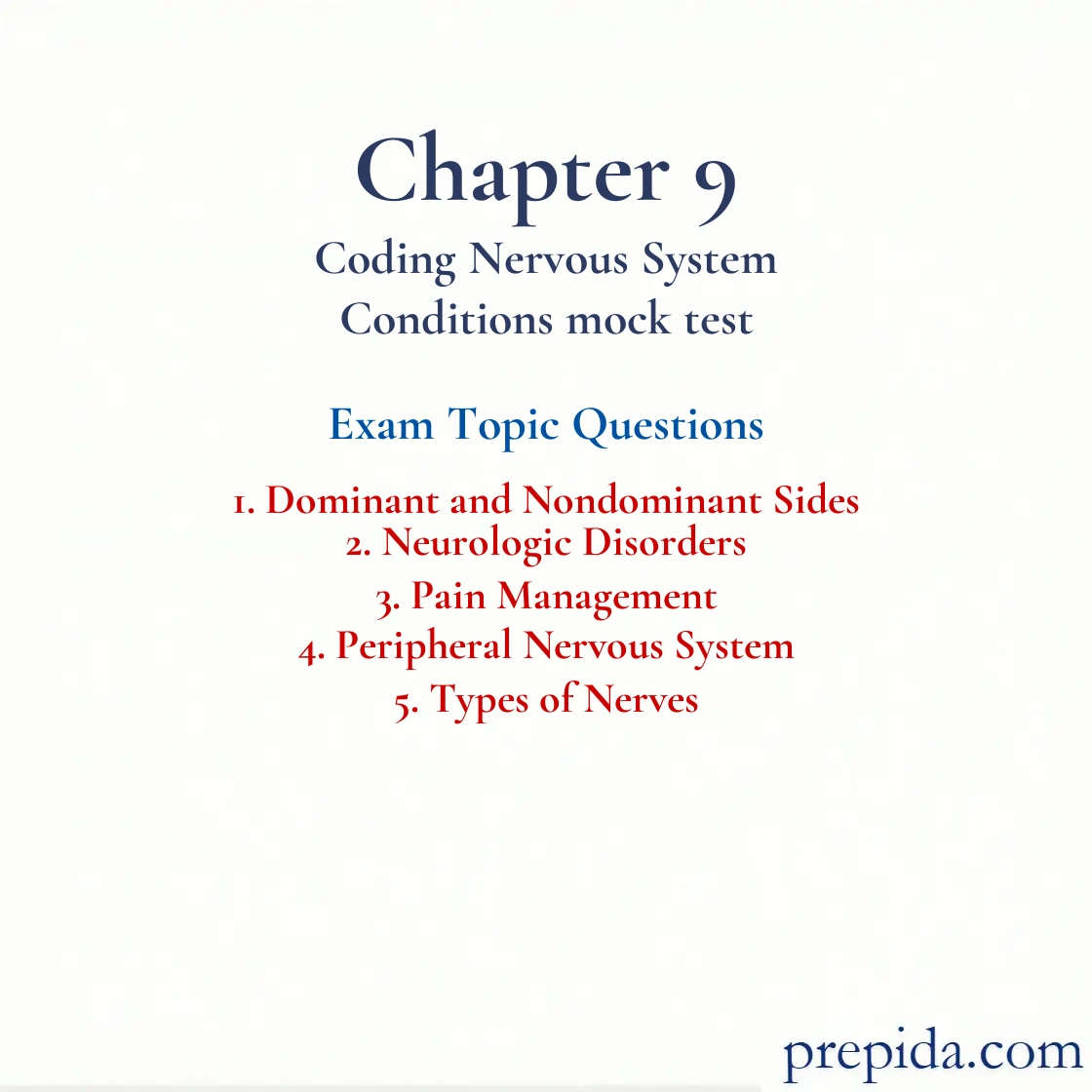
What is the correct code for a patient who is experiencing spastic hemiplegia on his left side?
- G81.10
- G81.12
- G81.13
- G81.14
The correct code for a patient who is experiencing spastic hemiplegia on his left side is G81.14. G81.14: hemiplegia>spastic>left nondominant side.
Diagnosis: A physician’s determination of a patient’s condition, illness, or injury.
A patient suffering from weakness of one side of the body has which condition?
- Hemiplegia
- Hemiparesis
- Monoplegia
- Monoparesis
Hemiparesis is weakness of one side of the body.
Condition: A health-related situation.
A patient suffering from paralysis of the dominant right side of the body following a cerebral infarction is assigned which code?
- G81.0
- G81.9
- I69.351
- I69.151
A patient suffering from paralysis of the dominant right side of the body following a cerebral infarction is assigned code I69.351. I69.351: Index>sequelae>infarction>cerebral>hemiplegia>right.
Infarction: Tissue or muscle that has deteriorated or died (necrotic).
What does ambidextrous mean?
- That a person is right-handed
- That a person is left-handed
- That a person uses both hands equally
- That a person has an amputated hand
Ambidextrous means that a person can use both hands equally.
Anomaly: Abnormal, or unexpected, condition.
What is the correct code assigned for a patient with a cerebral infarction due to a thrombosis of the left carotid artery?
- I63.031
- I63.032
- I63.033
- I63.039
The correct code for a patient with a cerebral infarction due to a thrombosis of the left carotid artery is I63.032. I63.032: Index>infarction>cerebral>due to>thrombosis>precerebral artery>left.
Infarction: Tissue or muscle that has deteriorated or died (necrotic).
What does a score of 9 on the Glasgow Coma Scale indicate?
- The patient has a severe head injury.
- The patient has a moderate head injury.
- The patient has a mild head injury.
- The patient does not have a head injury.
The patient has a moderate head injury if the Glasgow Coma Scale is between 9 and 12.
What is the correct code assigned for a patient with an intractable abdominal migraine?
- G43.A0
- G43.A1
- G43.D0
- G43.D1
The correct code for an intractable abdominal migraine is G43.D1. G43.D1: Index>migraine>abdominal>intractable.
Sign: Objective evidence of a disease or condition.
Where in the documentation can a coder read about the patient's mental status?
- History of present illness
- Glasgow Coma Scale
- Physical exam
- Stroke assessment
The physician will document the patient's mental status in the history of present illness.
Diagnosis: A physician’s determination of a patient’s condition, illness, or injury.
What does the abbreviation ADLs stand for?
- Activities of daily living
- Adults with developmental limits
- Activities to develop learning
- Adults in daily life
ADLs stands for activities of daily living.
Functional Activity: Glandular secretion in abnormal quantity.
What is the correct code assigned for a patient with other chronic pain?
- G89.0
- G89.18
- G89.2
- G89.29
The correct code for a patient with other chronic pain is G89.29. G89.29: Index>pain>chronic.
Chronic: Long duration; continuing over a long period of time.
What is the correct code assigned for a patient with chronic pain syndrome?
- G89.0
- G89.28
- G89.29
- G89.4
The correct code for a patient with chronic pain syndrome is G89.4. G89.4: Index>pain>chronic>associated with significant psychosocial dysfunction.
Chronic: Long duration; continuing over a long period of time.
Which cranial nerves are the largest?
- Olfactory nerves
- Optic nerves
- Oculomotor nerves
- Trigeminal nerves
The trigeminal nerves are the largest cranial nerves.
Which cranial nerves are responsible for raising the eyelid and moving the eye?
- Olfactory nerves
- Optic nerves
- Oculomotor nerves
- Trigeminal nerves
The oculomotor nerves are responsible for raising the eyelid and moving the eye.
Anatomical Site: A specific location or part of the human body.
Which cranial nerves are linked with vision?
- Olfactory nerves
- Optic nerves
- Oculomotor nerves
- Trochlear nerves
The optic nerves are linked with vision.
Outpatient Services: Health care services provided to individuals without an overnight stay in the facility.
Which cranial nerves are responsible for the sense of smell?
- Olfactory nerves
- Optic nerves
- Oculomotor nerves
- Trochlear nerves
The olfactory nerves are related to the sense of smell.
Anatomical Site: A specific location or part of the human body.
How many pairs of spinal nerves are there?
- 16
- 22
- 28
- 31
There are 31 pairs of spinal nerves.
Gestation: The length of time for the complete development of a baby from conception to birth; on average 40 weeks.
How many pairs of cranial nerves are there?
- 6
- 8
- 10
- 12
There are 12 pairs of cranial nerves.
Which nervous system instructs the activities of smooth muscles?
- Autonomic nervous system
- Central nervous system
- Peripheral nervous system
- None of these
The autonomic nervous system instructs the activities of the cardiac muscle and smooth muscles.
Which nerves stimulate skeletal muscle?
- Asomatic nerves
- Somatic nerves
- Vasopressin nerves
- Vasomotor nerves
The somatic nerves stimulate skeletal muscle and somatic tissue.
Which nerves regulate the opening and closing of blood vessels?
- Asomatic nerves
- Somatic nerves
- Vasopressin nerves
- Vasomotor nerves
The vasomotor nerves are responsible for regulating the dilation and constriction of blood vessels.
Hypertension: High blood pressure, usually a chronic condition; often identified by a systolic blood pressure above 140 mm/Hg and/or a diastolic blood pressure above 90 mm/Hg.
Which nervous system includes all the neurons, nerves, ganglia, and plexuses?
- Autonomic nervous system
- Central nervous system
- Peripheral nervous system
- None of these
The peripheral nervous system includes all the neurons, nerves, ganglia, and plexuses that reach outward from the CNS.
Which nervous system involves these two organs: the brain and the spinal cord?
- Autonomic nervous system
- Central nervous system
- Peripheral nervous system
- None of these
The central nervous system involves the brain and the spinal cord.